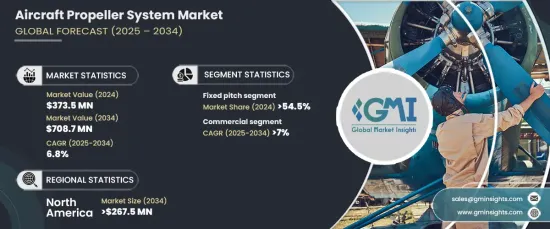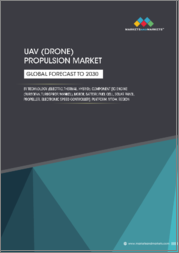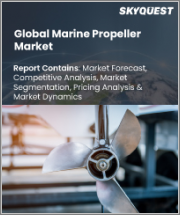
|
시장보고서
상품코드
1665392
항공기 프로펠러 시스템 시장 기회, 성장 촉진요인, 산업 동향 분석, 예측(2025-2034년)Aircraft Propeller System Market Opportunity, Growth Drivers, Industry Trend Analysis, and Forecast 2025 - 2034 |
||||||
세계의 항공기 프로펠러 시스템 시장은 2024년 3억 7,350만 달러로 추정되며, 항공 산업의 지속가능성에 대한 관심 증가와 대체 추진 시스템 채택으로 인해 2025-2034년간 연평균 6.8% 성장할 것으로 예상됩니다. 이산화탄소 배출량 감축이 추진되고 있는 가운데, 수소전기 추진 기술은 기존 화석연료를 대체할 수 있는 친환경 기술로 각광받고 있습니다.

이러한 시스템은 항공사가 완전히 새로운 항공기에 투자하는 대신 기존 항공기를 개조할 수 있는 기회를 제공함으로써 인프라 비용을 절감하고 환경 발자국을 줄일 수 있습니다. 수소 전기와 함께 데이터 분석, 인공지능, 자동화와 같은 디지털 기술의 발전은 항공 부문에 혁명을 가져와 항공기 운영의 효율성과 지속가능성을 향상시키고 있습니다. 전 세계 항공 여행이 회복세를 보이고 있는 가운데, 특히 도심항공모빌리티와 전기 수직이착륙(eVTOL) 항공기와 같은 에너지 효율적이고 친환경적인 항공 기술에 대한 수요가 시장 성장을 가속할 것으로 예상됩니다.
| 시장 범위 | |
|---|---|
| 시작연도 | 2024년 |
| 예측연도 | 2025-2034년 |
| 시작 금액 | 3억 7,350만 달러 |
| 예상 금액 | 7억 870만 달러 |
| CAGR | 6.8% |
시장은 고정 피치 부문과 가변 피치 부문으로 나뉩니다. 고정 피치 부문이 2024년 시장을 장악하여 54.5% 이상의 점유율을 차지하고 있습니다. 이 부문은 소형 지역 항공기에서 고정 피치 프로펠러의 사용이 증가함에 따라 향후에도 급성장할 것으로 예상됩니다. 고정 피치 프로펠러는 간단한 조작성, 저렴한 가격, 최소한의 유지보수가 필요한 것으로 알려져 있으며, 경비행기 및 단거리 비행에 가장 적합한 것으로 알려져 있습니다. 지역 항공이 확대됨에 따라 항공사는 비용 효율적이고 연료 효율이 높은 항공기를 선택하게 되면서 고정 피치 시스템에 대한 수요가 더욱 증가하고 있습니다.
기술의 발전으로 고정 피치 프로펠러의 성능과 수명이 향상되고 있습니다. 제조업체들은 성능을 유지하면서 프로펠러의 내구성과 내식성을 향상시킬 수 있는 경량 합금 및 복합재료에 점점 더 많은 관심을 기울이고 있습니다. 이러한 기술 혁신을 통해 고정 피치 프로펠러는 항공 분야에서 비용 효율적이고 고성능 솔루션에 대한 수요 증가에 대응할 수 있게 되었습니다.
항공기 프로펠러 시스템 시장은 또한 플랫폼에 따라 세분화되며, 민간용과 군용으로 분류됩니다. 민간 항공 부문은 2034년까지 연평균 7% 이상의 CAGR을 나타낼 것으로 예상됩니다. 특히 신흥 시장에서는 지역 항공 여행이 계속 증가함에 따라 더 작고 효율적인 항공기에 대한 수요가 증가하고 있으며, 고정 피치 및 가변 피치 프로펠러 시스템에 대한 요구가 증가하고 있습니다. 또한 항공사들은 에너지 효율과 성능을 최적화하기 위해 첨단 프로펠러 기술을 필요로 하는 하이브리드 전기 추진 시스템 및 전기 추진 시스템에 투자하고 있습니다. 이러한 지속가능한 항공 연료(SAF)와 친환경 추진 방식으로의 전환은 민간 항공 시장의 성장을 더욱 촉진하고 있습니다.
북미는 세계 시장을 선도하고 있으며, 미국은 2034년까지 2억 6,750만 달러에 달할 것으로 예상됩니다. 이 지역의 우위는 제조업체들이 성능 향상과 혁신 기술 통합에 집중하고 있기 때문입니다. 환경 규제 준수와 지속가능성 목표 달성에 대한 관심이 높아지면서 연료 효율이 높고 친환경적인 추진 시스템에 대한 수요가 증가하고 있습니다. 그 결과, 경량화 및 고성능 프로펠러에 의존하는 하이브리드 기술 및 전기 기술 개발로 이어졌습니다.
목차
제1장 조사 방법과 조사 범위
- 시장 범위와 정의
- 기본 추정과 계산
- 예측 계산
- 데이터 소스
- 1차 데이터
- 2차 데이터
- 유료 정보원
- 공적 정보원
제2장 개요
제3장 산업 인사이트
- 에코시스템 분석
- 밸류체인에 영향을 미치는 요인
- 이익률 분석
- 변혁
- 향후 전망
- 제조업체
- 유통업체
- 공급업체 상황
- 이익률 분석
- 주요 뉴스
- 규제 상황
- 영향요인
- 촉진요인
- 지속가능성에 대한 관심의 증가와 항공 배출량 삭감의 필요성
- 연료 효율이 높은 추진 시스템에 대한 수요 증가
- 하이브리드 전기 추진 기술과 완전 전기 추진 기술의 채택 증가
- 도시 항공 모빌리티 용도의 eVTOL(전동 수직 이착륙) 항공기의 부상
- 군용기의 지속적 업그레이드와 현대화
- 산업의 잠재적 리스크·과제
- 높은 개발비
- 하이브리드와 전기 추진의 기술적 한계
- 촉진요인
- 성장 가능성 분석
- Porter의 산업 분석
- PESTEL 분석
제4장 경쟁 구도
- 서론
- 기업 점유율 분석
- 경쟁 포지셔닝 매트릭스
- 전략 전망 매트릭스
제5장 시장 추정·예측 : 유형별, 2021-2034년
- 주요 동향
- 고정 피치
- 가변 피치
- 가변 피치 프로펠러
- 정속 프로펠러
- 풀 페더링 프로펠러
- 기타
제6장 시장 추정·예측 : 컴포넌트별, 2021-2034년
- 주요 동향
- 블레이드
- 스피너
- 허브
- 기타
제7장 시장 추정·예측 : 엔진별, 2021-2034년
- 주요 동향
- 기존형 엔진
- 터보프롭 엔진
- 피스톤 엔진
- 전동 & 하이브리드
제8장 시장 추정·예측 : 플랫폼별, 2021-2034년
- 주요 동향
- 민간 항공기
- 협동체기
- 광동체기
- 비즈니스 제트기
- 군용기
- 운송기
- 특수 임무기
- 연습기
- 무인항공기(UAV)
제9장 시장 추정·예측 : 최종 용도별, 2021-2034년
- 주요 동향
- Original Equipment Manufacturer(OEM)
- 애프터마켓
제10장 시장 추정·예측 : 지역별, 2021-2034년
- 주요 동향
- 북미
- 미국
- 캐나다
- 유럽
- 영국
- 독일
- 프랑스
- 이탈리아
- 스페인
- 러시아
- 아시아태평양
- 중국
- 인도
- 일본
- 한국
- 호주
- 라틴아메리카
- 브라질
- 멕시코
- 중동 및 아프리카
- 남아프리카공화국
- 사우디아라비아
- 아랍에미리트
제11장 기업 개요
- Airmaster Propellers
- DUC Helices
- FP-Propeller
- General Electric
- GSC Systems
- Hartzell Propeller
- Hercules Propellers
- Jabiru Aircraft
- MT-Propeller
- RTX
- Sensenich Wood Propeller
- Textron Aviation
- Whirl Wind Propellers
The Global Aircraft Propeller System Market, with an estimated valuation of USD 373.5 million in 2024, is expected to expand at a CAGR of 6.8% from 2025 to 2034, driven by the aviation industry's increasing focus on sustainability and the adoption of alternative propulsion systems. With the ongoing push to reduce carbon emissions, hydrogen-electric propulsion technologies are gaining traction as an environmentally friendly alternative to traditional fossil fuels.

These systems provide airlines with the opportunity to retrofit existing aircraft rather than invest in entirely new fleets, leading to reduced infrastructure costs and a lower environmental footprint. Alongside hydrogen-electric power, advancements in digital technologies such as data analytics, artificial intelligence, and automation are revolutionizing the aviation sector, improving the efficiency and sustainability of aircraft operations. As global air travel continues to recover, the demand for more energy-efficient and eco-friendly aviation technologies, particularly in urban air mobility and electric vertical take-off and landing (eVTOL) aircraft, is expected to fuel market growth.
| Market Scope | |
|---|---|
| Start Year | 2024 |
| Forecast Year | 2025-2034 |
| Start Value | $373.5 Million |
| Forecast Value | $708.7 Million |
| CAGR | 6.8% |
The market is divided into fixed pitch and variable pitch segments. The fixed pitch segment dominated the market in 2024, holding over 54.5% of the share. This segment is forecast to continue growing rapidly due to the increasing use of fixed pitch propellers in smaller, regional aircraft. Fixed pitch propellers are known for their simple operation, affordability, and minimal maintenance needs, making them ideal for light aircraft and short-haul flights. As regional aviation expands, airlines are increasingly opting for cost-effective, fuel-efficient aircraft, driving further demand for fixed pitch systems.
Technological advancements are improving the performance and longevity of fixed pitch propellers. Manufacturers are increasingly turning to lightweight alloys and composite materials, which enhance propeller durability and resistance to corrosion while maintaining performance. These innovations allow fixed pitch propellers to meet the growing demand for cost-effective and high-performance solutions in the aviation sector.
The aircraft propeller system market is also segmented based on platform, with commercial and military applications. The commercial aviation sector is expected to experience a CAGR of over 7% until 2034. As regional air travel continues to expand, particularly in emerging markets, there is a growing demand for smaller, more efficient aircraft, increasing the need for both fixed and variable pitch propeller systems. Additionally, airlines are investing in hybrid-electric and electric propulsion systems, which require advanced propeller technologies to optimize energy efficiency and performance. This shift toward sustainable aviation fuels (SAFs) and greener propulsion methods is driving further growth in the commercial aviation market.
North America is leading the global market, with the U.S. anticipated to reach USD 267.5 million by 2034. The region's dominance is attributed to manufacturers focusing on improving performance and integrating innovative technologies. The increasing emphasis on meeting environmental regulations and achieving sustainability goals has heightened demand for fuel-efficient and eco-friendly propulsion systems. This, in turn, has led to the development of hybrid and electric technologies that rely on lightweight, high-performance propellers.
Table of Contents
Chapter 1 Methodology & Scope
- 1.1 Market scope & definitions
- 1.2 Base estimates & calculations
- 1.3 Forecast calculations
- 1.4 Data sources
- 1.4.1 Primary
- 1.4.2 Secondary
- 1.4.2.1 Paid sources
- 1.4.2.2 Public sources
Chapter 2 Executive Summary
- 2.1 Industry synopsis, 2021-2034
Chapter 3 Industry Insights
- 3.1 Industry ecosystem analysis
- 3.1.1 Factor affecting the value chain
- 3.1.2 Profit margin analysis
- 3.1.3 Disruptions
- 3.1.4 Future outlook
- 3.1.5 Manufacturers
- 3.1.6 Distributors
- 3.2 Supplier landscape
- 3.3 Profit margin analysis
- 3.4 Key news & initiatives
- 3.5 Regulatory landscape
- 3.6 Impact forces
- 3.6.1 Growth drivers
- 3.6.1.1 Increasing focus on sustainability and the need to reduce aviation emissions
- 3.6.1.2 Growing demand for fuel-efficient propulsion systems
- 3.6.1.3 Increasing adoption of hybrid-electric and fully electric propulsion technologies
- 3.6.1.4 Rise of eVTOL (electric vertical takeoff and landing) aircraft for urban air mobility applications
- 3.6.1.5 Ongoing upgrades and modernization of military aircraft fleets
- 3.6.2 Industry pitfalls & challenges
- 3.6.2.1 High development costs
- 3.6.2.2 Technological limitations of hybrid and electric propulsion
- 3.6.1 Growth drivers
- 3.7 Growth potential analysis
- 3.8 Porter’s analysis
- 3.9 PESTEL analysis
Chapter 4 Competitive Landscape, 2024
- 4.1 Introduction
- 4.2 Company market share analysis
- 4.3 Competitive positioning matrix
- 4.4 Strategic outlook matrix
Chapter 5 Market Estimates & Forecast, By Type, 2021-2034 (USD Million)
- 5.1 Key trends
- 5.2 Fixed pitch
- 5.3 Variable pitch
- 5.3.1 Controllable pitch propeller
- 5.3.2 Constant speed propeller
- 5.3.3 Full feathering propeller
- 5.3.4 Others
Chapter 6 Market Estimates & Forecast, By Component, 2021-2034 (USD Million)
- 6.1 Key trends
- 6.2 Blade
- 6.3 Spinner
- 6.4 Hub
- 6.5 Others
Chapter 7 Market Estimates & Forecast, By Engine, 2021-2034 (USD Million)
- 7.1 Key trends
- 7.2 Conventional
- 7.2.1 Turboprop engine
- 7.2.2 Piston engine
- 7.3 Electric & hybrid
Chapter 8 Market Estimates & Forecast, By Platform, 2021-2034 (USD Million)
- 8.1 Key trends
- 8.2 Commercial
- 8.2.1 Narrow- Body aircraft
- 8.2.2 Wide-Body aircraft
- 8.2.3 Business jet
- 8.3 Military
- 8.3.1 Transport aircraft
- 8.3.2 Special mission aircraft
- 8.3.3 Trainer aircraft
- 8.3.4 Unmanned Aerial Vehicle (UAV)
Chapter 9 Market Estimates & Forecast, By End Use, 2021-2034 (USD Million)
- 9.1 Key trends
- 9.2 Original Equipment Manufacturer (OEM)
- 9.3 Aftermarket
Chapter 10 Market Estimates & Forecast, By Region, 2021-2034 (USD Million)
- 10.1 Key trends
- 10.2 North America
- 10.2.1 U.S.
- 10.2.2 Canada
- 10.3 Europe
- 10.3.1 UK
- 10.3.2 Germany
- 10.3.3 France
- 10.3.4 Italy
- 10.3.5 Spain
- 10.3.6 Russia
- 10.4 Asia Pacific
- 10.4.1 China
- 10.4.2 India
- 10.4.3 Japan
- 10.4.4 South Korea
- 10.4.5 Australia
- 10.5 Latin America
- 10.5.1 Brazil
- 10.5.2 Mexico
- 10.6 MEA
- 10.6.1 South Africa
- 10.6.2 Saudi Arabia
- 10.6.3 UAE
Chapter 11 Company Profiles
- 11.1 Airmaster Propellers
- 11.2 DUC Helices
- 11.3 FP-Propeller
- 11.4 General Electric
- 11.5 GSC Systems
- 11.6 Hartzell Propeller
- 11.7 Hercules Propellers
- 11.8 Jabiru Aircraft
- 11.9 MT-Propeller
- 11.10 RTX
- 11.11 Sensenich Wood Propeller
- 11.12 Textron Aviation
- 11.13 Whirl Wind Propellers



















